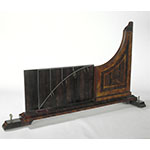The apparatus was probably first described by Willem Jacob 's Gravesande in Physices elementa mathematica, experimentis confirmata (3rd ed., Leiden, 1742). It demonstrates experimentally that gravitational acceleration causes a body launched horizontally to describes a parabolic trajectory.
A wooden base, fitted with leveling screws, holds a stand with a quarter-circle track and vertical panel on which a series of four brass rings are fixed at equal distances along a parabola. A ball falling down the track experiences a constant acceleration. When no longer supported by the track, the ball's horizontal projection is combined with the natural motion of uniformly accelerated fall; the ball's path thus becomes parabolic, as evidenced by the fact that it goes through the entire series of rings. The experiment confirms Galileo's discovery of the parabolic trajectory of bodies as the result of the combination of horizontal projection and free fall, defined by the Pisan scientist in c. 1609 and first published in the Giornata Quarta [Fourth Day] of the Discorsi and dimostrazioni matematiche intorno a due Nuove Scienze (Leiden, 1638). Provenance: Lorraine collections.










